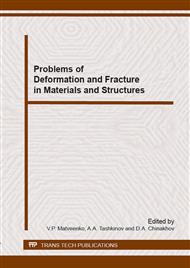[1]
Marecos J., The measurement of vertical displacements through water levelling method, Materials and Structures. 11 (5) (1978) 361-370.
DOI: 10.1007/bf02473877
Google Scholar
[2]
Yin Z.Z., Application of Hydrostatic Leveling System in Metro Monitoring for Construction Deep Excavation above Shield Tunnel, Applied Mechanics and Materials. 333-335 (2013) 1509-1513.
DOI: 10.4028/www.scientific.net/amm.333-335.1509
Google Scholar
[3]
Sun Z., Zhang S., Liu N., Application and analysis of hydrostatic level gauges in deformation monitoring of subway tunnels during operation, Modern Tunneling Technology. 52 (1) (2015) 203-208.
Google Scholar
[4]
Chen Z.J., Zhang N.N., Zhang X.W., Settlement monitoring system of pile-group foundation, J. Cent. South Univ. Technol. 18 (2011) 2122-2130.
DOI: 10.1007/s11771-011-0952-7
Google Scholar
[5]
Meier E., Geiger A., Ingensand H., Licht H., Limpach P., Steiger A., Zwyssig R., Hydrostatic Levelling System: measuring at the system limits, J. of App. Geodesy. 4 (2010) 91-102.
DOI: 10.1515/jag.2010.009
Google Scholar
[6]
Morishita T., Ikegami M., The slow-ground-motion monitoring based on the hydrostatic leveling system in J-PARC linac, Nuclear Instruments and Methods in Physics Research Sec.A. 602 (2) (2009) 364-371.
DOI: 10.1016/j.nima.2009.01.152
Google Scholar
[7]
Manukin A.B., Kazantseva O.S., Bekhterev S.V., Matyunin V.P., Kalinnikov I.I., Long base hydrostatic level, Seismic Instruments. 50 (3) (2014) 238-243.
DOI: 10.3103/s0747923914030074
Google Scholar
[8]
Sengupta D., Kishore P., Continuous liquid level monitoring sensor system using fiber Bragg grating, Optical Engineering. 1 (2014) 8.
DOI: 10.1117/1.oe.53.1.017102
Google Scholar
[9]
Parker D.H., Radcliff B., Shelton J.W., Advances in hydrostatic leveling with the NPH6, and suggestions for further enhancements, Precision Engineering. 29 (3) (2005) 367-374.
DOI: 10.1016/j.precisioneng.2004.11.001
Google Scholar
[10]
Taimazov D.G., Three-fluid hydrostatic level, Seismic Instruments. 46 (1) (2010) 75-77.
DOI: 10.3103/s0747923910010081
Google Scholar
[11]
Bowles J.E., Foundation analysis and design, McGraw-Hill Companies, Singapore, (1997).
Google Scholar


